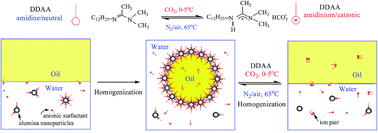CO2/N2 triggered switchable Pickering emulsions stabilized by alumina nanoparticles in combination with a conventional anionic surfactant†
Abstract
Stable n-decane-in-water Pickering emulsions were prepared using positively charged alumina nanoparticles in combination with a trace amount of the anionic surfactant sodium dodecyl sulfate (SDS) as a stabilizer. Particles were hydrophobized in situ by adsorption of surfactant enhancing their surface activity. Emulsions can be readily demulsified by addition of an equal amount of a switchable surfactant, N′-dodecyl-N,N-dimethylacetamidine (DDAA), which can be transformed between a surface-active amidinium/cationic form and a surface-inactive amidine/neutral form by bubbling CO2 or N2, respectively. Following addition of cationic DDAA which prefers to form ion pairs with SDS, desorption of SDS from particle surfaces occurs and alumina particles are rendered hydrophilic resulting in demulsification of the emulsion. However, by bubbling N2 into the demulsified mixture, DDAA molecules are converted to the amidine/neutral form leading to collapse of the ion pairs and re-establishment of the in situ hydrophobization of particles. Stable Pickering emulsions can be prepared again following homogenization. This simple demulsification/re-stabilization cycle can be repeated several times. Experimental evidence including measurement of the adsorption isotherm, zeta potentials, extent of particle adsorption at droplet interfaces in emulsions and microscopy is given to support the postulated mechanisms.



 Please wait while we load your content...
Please wait while we load your content...